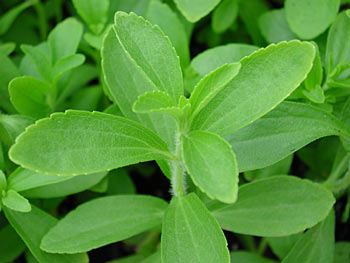- Stevia plants grow and are harvested in many countries around the world, predominantly in China and Brazil. The plants grow 2-4 feet in height with slim, branched stems, and thrive in temperate and some tropical regions. Stevia is grown by natural, conventional plant breeding methods such as cross-pollination and other non-genetically modified processes.
Contents
Uses
- Stevia is an intensely sweet natural sweetener that is harvested around the world from the stevia rebaudiana plant.
- The plant is cultivated as a commercial crop in Japan, China, Kenya, Vietnam, India, Argentina, Colombia, Thailand, Paraguay, and Brazil. Currently, China is the leading exporter of stevia products.8,19
- Stevia provides an important role in biodiversity due to how little land is required to grow it, allowing farmers to diversify their crops. Unlike commodity crops, stevia is grown on smaller plots of land and provides supplemental income to more commonplace crops.
Benefits
- As stevia is intensely sweet and an extract, it typically requires only a fifth of the land and much less water to provide the same amount of sweetness as other mainstream sweeteners. For example, in Kenya, stevia is typically grown on only a third of the land, with the rest of the land being devoted to other crops.
- Stevia is a sweetener that is naturally low in calories and does not raise your blood sugar level when consumed.
- In a 2013 study, the carbon footprint of stevia was shown to be 79% lower than high fructose corn syrup (HFCS), 55% lower than beet sugar, and 29% lower than cane sugar, based on industry production standards.
Cautions
- Allergic Reactions: In some cases, stevia can cause a severe allergic reaction called anaphylaxis, but this is a relatively rare occurrence. According to the New Health Guide website, however, those with pre-existing allergies to chrysanthemums, marigolds, ragweed or daisies are at greater risk of a stevia reaction. Symptoms of an allergic reaction include dizziness, hives, shortness of breath, wheezing, general weakness or having a hard time swallowing shortly after consuming stevia. If any of these symptoms present themselves, seek emergency medical attention immediately.
- Reactions in the Digestive System: Because of its low calorie content, stevia is often used as a natural sugar substitute for those who are looking to lose weight. According to the New Health Guide, however, consuming highly refined stevia can lead to feelings of nausea and a misleading sensation of fullness in some people. Stevia contains steviosides, which may irritate your stomach and cause other problems for the digestive system, including, bloating and a decreased appetite. If you experience these symptoms only mildly, stop taking stevia, and speak with a doctor if the symptoms do not stop shortly.
Interactions
- In some cases, stevia can lead to an adverse reaction if it is consumed with certain medications. Ingesting stevia and lithium is not recommended as stevia can cause your body to retain higher amounts of the drug. As well, stevia is not recommended if you are taking medication to treat diabetes.
- Some studies suggest that diabetes medication and stevia, when taken together, can cause hypoglycemia, a drop in blood sugar levels. In a similar way, research suggests stevia may cause a drop in blood pressure for people taking blood pressure medication. If you’re taking any of these medications, check with your health care provider before using stevia.
Other Names
Some of the common and trade names for stevia sweeteners are Enliten, PureVia, Rebaudioside A/Reb A, Rebaudioside B, Rebaudioside C, Rebaudioside D, Rebiana, Stevia, Steviacane, Steviol Glycosides, Stevioside, Stevia Extract In The Raw, and SweetLeaf.
References
- Source: Medical News Today, http://www.medicalnewstoday.com/articles/287251.php
- Source: Lalonde, Bethany; “Known Side Effects of Stevia”, 14 Apr 2015, www.livestrong.com/article/368454-known-side-effects-of-stevia/

